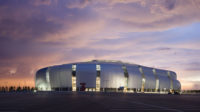The mere thought of a high-profile architect designing a shop for a well-known fashion designer raises the old question: Will the container dominate the contained—i.e., the clothes? After all, artists often complain about new architecturally splashy museums overwhelming exhibited works. Nevertheless, fashion seems to hold its own: In his Calvin Klein store in New York City, Minimalist architect John Pawson created a hushed, monumentally Modern citadel for sculpturally austere garments where both contents and surroundings meet in perfect accord. And despite Rem Koolhaas’s rowdy romp through two levels of the Prada store in the SoHo neighborhood of New York City, the interior’s theatrical design-as-destination encourages curious throngs to peruse the equally provocative jolie-laide items on display.
In some cases, such as the Derek Lam shop in SoHo, fashion dominates while permitting the architect’s imprimatur to remain flagrantly intact. Designed by Kazuyo Sejima and Ryue Nishizawa, principals of the Japanese firm SANAA, with New York executive architect Toshihiro Oki, the store makes clear that the container need not be boring.
Although Sejima, Nishizawa, and Oki recently worked together on the New Museum of Contemporary Art on Manhattan’s Lower East Side [record, March 2008, page 132], with Derek Lam’s shop, they explored themes that underpin their curvilinear Toledo Museum of Art Glass Pavilion in Ohio. In the Toledo project, curving glass acts as both enclosing walls and interior partitions. In the Derek Lam shop, contoured, clear acrylic sinuously winds through the 2,700-square-foot ground floor of a 19th-century loft building: Biomorphic panels 1 inch thick, 12 feet high, and 24 feet long separate and display different types of women’s apparel.
Lam, a Chinese-American fashion designer, who founded the firm in 2002, had gotten to know Sejima over the years, and after the Austrian firm Labelux bought a majority stake in the company, he turned to SANAA to create his first stand-alone store. (An architectural design firm, SO-IL, is renovating the second and third floors of the brick structure for Lam’s production ateliers, another showroom, and offices.) Lam’s clothing designs, which emphasize a feminine, sensuous cut, appeal to a client who prefers a constructed but not overly aggressive look. For his often fluid and draped apparel, the SANAA team came up with a delicate, diaphanous ambience where clothes stand out like sculptural objets. This is not the sort of place where you pop in, determined to find something in 30 seconds or be out of there. It makes you screech to a halt, partially because you could easily crash into an acrylic curve, or find yourself in a bubble with no way out.
The largest bubble, designed to function as a showroom for buyers, can be closed off by a gold-and-silver woven lighting scrim for privacy; a small bulbous protrusion doubles as a model’s fitting room. To expedite matters, buyers enter and exit the shop through a side door nearby. In a peanut-shaped bubble, SANAA inserted a curving aluminum shelf along the edges to display Lam’s shoes and handbags. These low shelves, along with Mexican mahogany display tables, serve as reminders—plus the occasional small tree and myriad reflections—of the almost transparent barriers. Dematerialization has its dangers.
This perceptual transparency and the lambent sheen of the curved acrylic panels ingeniously solve a problem endemic to a loft building: Clear partitions let daylight permeate much of the shop, even affording glimpses through rear windows of a light-filled courtyard. By removing ducts and pipes—letting the original radiators remain—and inserting a bank of offices along the south side of the store, the architects kept the space open. (Storage is in the basement.) To heighten the sense of ethereality, SANAA painted the brick walls and cast-iron columns white, installed a suspended white Sheetrock ceiling, and covered the floor with pale concrete. Bounced reflections on the concrete-and-acrylic surfaces generate a misty luminescence from which the clothes boldly emerge.
In installing the acrylic “furniture,” as Oki calls it, the team turned to aquarium manufacturers to cast the large contoured panels, which need no support, owing to their weight and shape. At strategic points, stainless-steel clips, placed 16 inches from the bottom and top of the panels, join the elements and serve as subtle reminders of the presence of these almost invisible partitions.
Arguably, the interior seems like a diminutive knock-off of the Toledo pavilion. But its deployment of acrylic forms and light surfaces makes an elegant case for adapting an ingenious concept to a dark, generic SoHo loft. And you can really see the clothes.
PeopleArchitect: Personnel in architect's firm who should receive special credit: Principals: Sejima, Ryue Nishizawa Team: Sam Chermayeff, Tommy Haddock, Executive architect: Toshihiro Oki, Engineer(s): Consultant(s): M/E/P: Plus Group Photographer(s):
|
ProductsAcrylic: Reynolds Polymer, Technology; ATM (fabricator) Gold curtains: Shading Systems Concrete floor: Concrete Concepts Paint: Sherwin Williams
|












Post a comment to this article
Report Abusive Comment